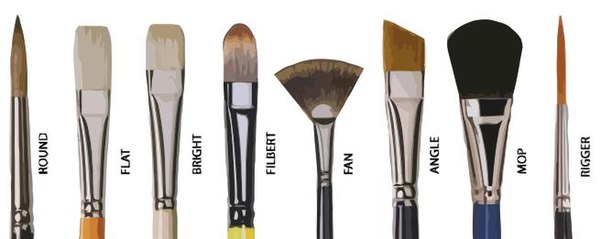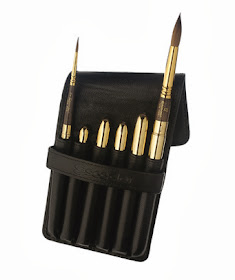I always need more of these types of guides, as my brushes are often rather horrible. So need some insight? Here is a very comprehensive guide to a sometimes very neglected side of our hobby.... Brushes.
This is just an intro, so for the entire article, please head over to Talk Wargaming. A huge thanks to Talk Wargaming for sharing this article with us today.
Shared with us via Talk Wargaming
http://www.talkwargaming.com/2014/04/tutorial-caring-for-your-paint-brushes.html
About 10 years ago I decided I wanted to do the painting thing a bit more seriously so I went out and purchased brushes that were aimed at artists.
I used Mastertouch and Winsor and Newton brushes that were designed for acrylic paints. I made an important discovery.
My painting really did improve, the control was better and I was able to do finer work. That said, the brushes still wore out quickly and so I decided to take some advice from some of the professional artists that I'd met and moved onto Kolinsky Sable brushes.
The first Kolinsky brush that I bought was on vacation at my mother's house.
It was a DaVinci 1526Y.
The brush was on sale and was cheap enough where if I decided that these were not for me I wouldn't waste a bunch of money.
Wow, I was sold from the start! The detail I was able to pull of was amazing, far better than any of the other cheaper brushes I'd been using. This sold me on the idea of using Kolinsky.
After about a week of doing research online I decided on using Winsor and Newton Series 7 brushes.
Some people will tell you that using a certain type of paintbrush will not make you a better painter but I say that it in fact will.
I noticed even more of an improvement to my painting when I started with these brushes. I was able to pull off blending better and easier and the tips stay incredibly sharp for a long time.
Let Me Explain Below.
Synthetic
Bristles
With these types of brushes they are made out of a polyester or Nylon heck can even be a mixture of both made by the thousands in factories all around the globe. You can get a bag of these brushes for the same price it would cost you for one Kolinsky Sable, but that's not a problem.
What these types of brushes are good for is doing the really dirty work such as dry brushing, priming(unless you spray it on), base coating, spreading around glue you get the idea. These are best to use for everything unrelated to detailing of the miniature.
Belly Quality
Depending on what brand or non-brand you buy determines the quality. If a brush doesn't last long your margin of safety is that you didn't pay that much for it.
Brush Brands
The company I would recommend to get these types of brushes from is the Princeton Brush Company despite there being many more companies out there.
 |
| https://www.thearmypainter.com/ |
For Informational/Educational Purposes Only
Recommended Brushes/Sets
Different Types Of Brushes And The Purpose Of Each
Round
These brushes are useful for when it comes to getting the detail and painting those places no other brush can. Also round bristle brushes are great for manual priming because of the accurate points they have.
Flat
The ultimate brush for all your dry brushing needs no matter the size.
Bright
The difference between this and the flat brush are the curved edges which enable the painter to paint in small strokes thickly. Good for detailing/weathering larger miniatures or vehicles.
Filbert
With this brush it will help cover more ground faster while painting larger miniatures or vehicles while also being able to do detailing work on those larger miniatures without having to switch back to a round.
Fan
Great for light dry brushing on miniatures to give them that extra texture of dust or dirt using these with pigment works best.
Angle
Very similar to the flat brush by acting as a dry brush but can achieve more accuracy with the tip.
Mop
Another brush great for larger miniature dry brushing, but is also in general a great duster to freshen up miniatures that may have been sitting on the shelf a little to long.
Rigger
Can be used for the finest of details on a miniature especially the eyes.
Now most people will probably get sticker shock when they see the price on the Series 7 or any of the other fine art brushes but I will tell you why its better to go with them over the cheaper brushes.
While I was using cheaper brushes they would last maybe 3 months tops.
This meant I would replace them 4 times a year.
This meant I would replace them 4 times a year.
4 brushes a year x $3.00 brush = $12.00 per cheap brush per year.
This is also conservative, normally the brushes would only last a month or two tops.
So in reality I would be spending $24+ on cheap brushes just to paint.
A Winsor & Newton Series 7 Size: 1 is $14.09 (shipping included) and aWinsor & Newton Series 7 Size: 2 is $20.
Now I know what you're thinking, yes they do cost a lot from the start but in the long run you will save money.
I have had my Series 7 size 1 for over 4 years of painting.
I have had my Series 7 size 1 for over 4 years of painting.
1 Brush / 4 Years = $4.25 per year of use (and counting)
Now I understand some artists out there will replace their Kolinsky brushes once a year, but these are the guys who paint hundreds of minis on their brushes per year, and by paint I mean award winning stuff at contests/conventions.
So as you can see you will end up saving money, lots of money in the long run of using good quality paint brushes over the cheap brushes that you will get.
Now don't get me wrong, Winsor and Newton series 7 are not the only high end brushes out there, in a poll I did on several sites and twitter they are the most popular.
But here are some of the others that are used as well:
 |
| Da Vinci Maestro Series |
 |
| Rosemary & Co Series 33 |
Once you have these brushes...Of your choosing in your hand...you ready to get going?
No & Yes. Only if you don't care how to preserve your brushes for future use.
Now its time to figure out how the hell you take in account some fine...Brush Care.
You reach for your paintbrush only to find that the brush looks like Doc Brown after a severe electrocution.
Your brush has been a victim of bristle neglect, a problem which plagues the wargaming world.
Good brush care not only means that your paintbrush will last for longer it will also prevent your paint-jobs from being negatively impacted.
After all, how can you be expected to capture all of those little details when your brush is suffering from a bad case of fish tail.
Use
- Use the right brush for the job, fine brushes are best suited for detail work, thicker brushes tend to work well as wash brushes and flat brushes are excellent for dry brushing. Ensure that you only use your brush in it dedicated role to avoid unnecessary wear.
- Ensure that the paint covers no more than half the length of the bristles as this will not only make the brush harder to work with but it may also cause paint to build up at the base of the bristles.
- Rinse the brush frequently during painting, every 15 to 20 minutes is recommended. This helps to avoid a build up around the ferrule (the metal band) which can lead to fraying.
Cleaning
- Ensure that your brushes are thoroughly cleaned after every painting session. Use acrylic brush cleaners, which can be bought from most paint stores, for the best results. This removes paint residue and also restores the oils found in natural fiber brushes. Alternatively you can use a mild soap or shampoo such as those designed for babies.











